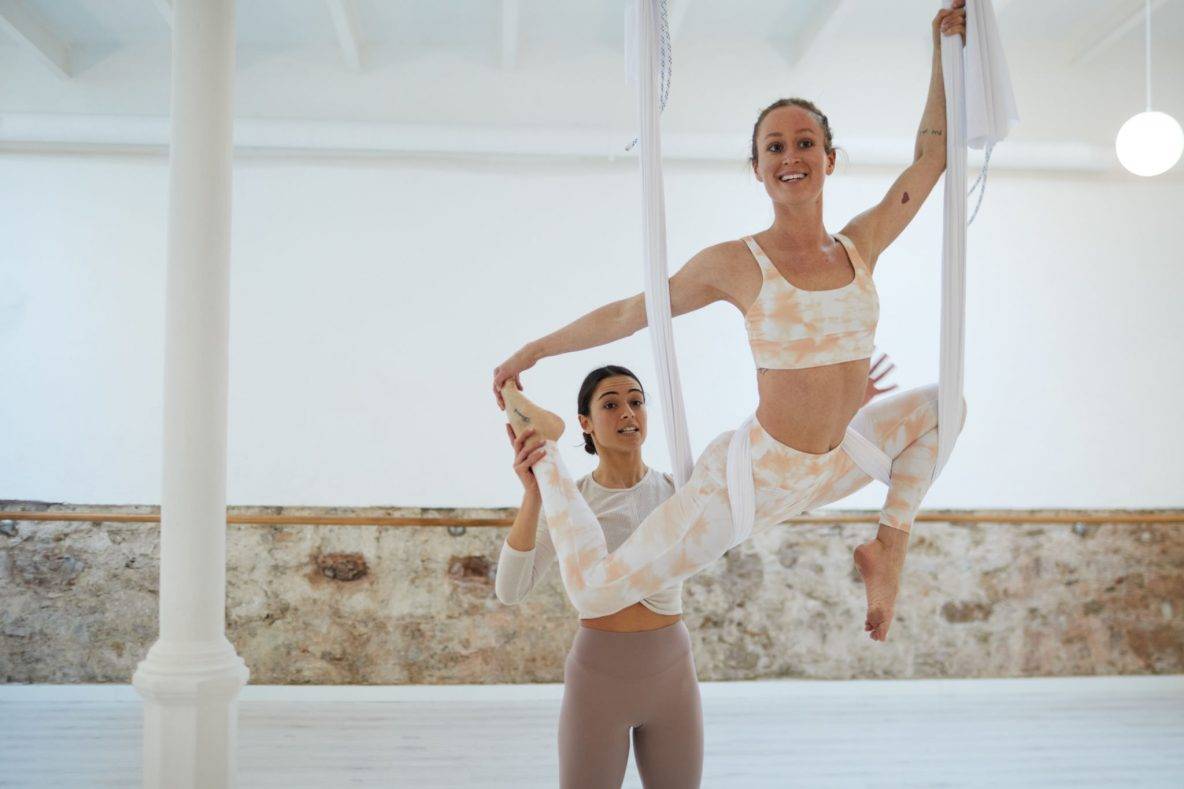Keep your eyes open—this is not your typical yoga sequence.
Your first exposure to the current fitness craze may have been via Instagram (#AerialYoga), which has been flooded with images of stunning, gravity-defying yoga poses. However, you do not have to be an acrobat to learn and enjoy aerial, or antigravity, workouts.
The classes gained traction in the form of yoga a few years ago (they’ve since expanded to include hybrids, such as aerial barre), attracting both newcomers and devoted yogis. The short version: Take a seat on a silky sling-like hammock suspended from the ceiling that supports your entire body weight. You’ll use the cloth to hold poses (like headstands) or do tricks (swings, back-flips) inside it, or you’ll utilize it similarly to a TRX suspension trainer, supporting your feet for push-ups and your palms for triceps dips. (Plus, the Instagram-worthy postures in silk hammocks.)
These unconventional workouts are not a gimmick: According to a new study conducted by the American Council on Exercise (ACE), women who participated in three 50-minute aerial yoga classes per week for six weeks lost an average of two and a half pounds, 2% body fat, and about one inch from their waist, all while increasing their VO2 max (a measure of fitness) by an astounding 11%. Indeed, aerial yoga is a moderate-intensity activity that occasionally deviates into vigorous terrain. More athletic classes, such as AIR (airfitnow.com), which combines elements of conditioning, Pilates, ballet, and HIIT, “elicit an even stronger physiological response,” according to study author Lance Dalleck, Ph.D., an assistant professor of exercise and sport science at Western State Colorado University. That translates to greater results!
Though aerial fitness was once considered something that could only be experienced in New York City or Los Angeles, its availability has increased. Crunch gyms (crunch.com) provide aerial yoga and aerial barre sessions throughout the country; Unnata Aerial Yoga (aerialyoga.com) is featured in studios across the country; and boutique clubs such as AIR have locations in a number of cities. You may even get your own hammock and perform an aerial workout in the comfort of your own home. (The Harrison AntiGravity Hammock is $295 at antigravityfitness.com and includes a hammock, everything you need to set it up, plus a workout DVD.)
As a result, it’s now easier than ever to enroll in a hammock class—and not just for the fat-burning benefits and significant improvement to your fitness level. This is what truly distinguishes aerial workouts from their ground-based counterparts. (Aerial yoga is only one of the new bizarre yoga methods you should try.)
- No special abilities (or footwear!) are necessary.
As an illustration, consider the ACE study’s test subjects: Sixteen randomly selected women ranging in age from 18 to 45 demonstrated that you can enter aerial workouts completely unprepared and still get the hang of things. Most aerial yoga facilities offer beginner sessions, and AIR also offers a “foundation” lesson for those just getting started. - It’s one of the most effective ab workouts available.
“An advantage of lifting your routine off the ground is that you lose your center of stability; you’ll automatically begin engaging your core,” explains Lindsey Duggan, owner of AIR Aerial Fitness–Los Angeles.
“It was honestly the most effective abdominal workout I’ve seen in a long time.” Not only did the women in the ACE research lose an inch, but Dalleck also provided anecdotal evidence that almost all of them felt their core strength increased significantly over the course of six weeks. (Are you pinned to the ground? Consider this vinyasa flow for shaping your abs.)
- You’re going to flip for the sheer excitement of it
Consider how enjoyable it is to spend an hour performing acrobatics. Suddenly, you’re performing acrobatic maneuvers that you might not attempt without the suspension silk’s assistance. “The fun factor is what keeps our clientele coming back,” Duggan explains. And you don’t need study to know that if you enjoy your workout, you’re more likely to do it on a regular basis. - Mat positions become more manageable
Have you been doing headstands or forearm stands in yoga? Consider this instead of kicking at a wall: “The silk wraps around your body and supports you in particularly difficult postures such as inversions, providing an experience of how a pose should feel,” Duggan explains. In other words, enrolling in a few aerial courses may help you improve your performance in conventional yoga classes as well. - It also qualifies as cardio.
The ACE researchers anticipated total-body firming. “Because study participants increased muscle mass and decreased fat mass throughout, aerial yoga is likely to have strength-building advantages,” Dalleck says. (Duggan advises that you should expect to see definition in your shoulders and arms in particular.) However, the scientists were somewhat aback by how cardio-intensive this style of yoga can be. “At the onset of the study, we did not anticipate that aerial yoga’s physiological reactions would be comparable to those of other, more typical kinds of aerobic exercise, such as cycling and swimming,” Dalleck explains. They discovered that the calorie expenditure from aerial yoga—320 calories in a 50-minute session—is comparable to that of power walking. - It has no adverse effect
Whether or not you have knee difficulties, incorporating some low- or no-impact activities to your routine is beneficial, and aerial sessions are particularly gentle on the knees, Dalleck says. - You’ll leave with a sense of accomplishment. Zen
Aerial yoga is no exception. Research indicates that mind-body activities can help alleviate stress. Numerous lessons conclude with savasana, in which you lie cocooned in a hammock and gradually swing from side to side. What a state of happiness!


